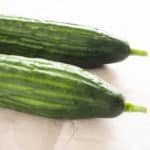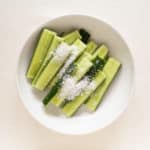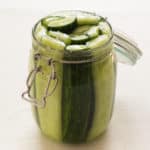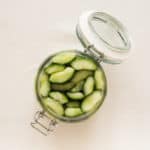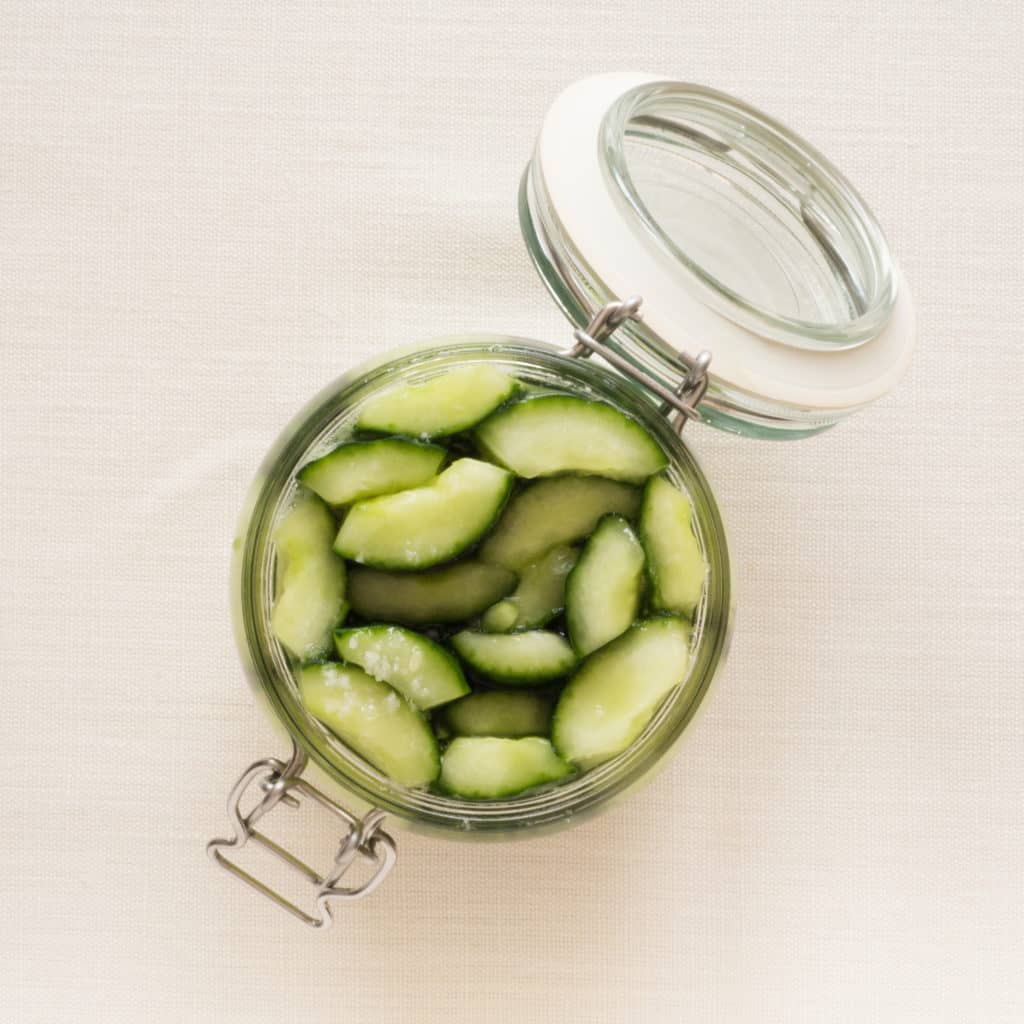
Preserved Cucumber is amazing. I adore almost any type of fermented or pickled vegetable. September is the time to get pickling, preserving and fermenting. Cucumbers (go for local – they taste better) are still wonderful in September, but they are coming to the end of the season, so to enjoy them through the winter and into next year get preserving.
Preserved Cucumber is easy and quick to make but you must ensure jars a properly sterilised.
Perfect for a light snack, in sandwiches, as a side with almost any type of food from Vietnamese to buffets. Serve with Vietnamese Summer Rolls, Garlic-Free Houmous , Gluten Free Vegan Rosemary and Sea Salt Crackers or as a side to a substantial salad such as Winter Vegetable Salad With Walnut Dressing
There are lots and lots of fermenting and pickle recipes around and you may well have a great, family recipe. I like this recipe for its simplicity of ingredients and method. If you want to know more about fermenting and preserving I can highly recommend The Art of Fermentation* by Sandor Ellix Katz. A wonderful book packed full of knowledge, passion and information (but not recipes as we traditionally know them). This book is my inspiration to try out different methods of preserving on the whole world of fruits and vegetables.
Allergy Information – Preserved Cucumber
Preserved Cucumber is celery free, coconut free, garlic free, gluten free, lupin free, mustard free, onion free, peanut free, sesame free, soya free, tree nut free, vegan.
Top Tips – Gluten Free, Vegan Sweet Squash (Pumpkin) Tart
Top tip. Sterilise jars in the dishwasher and be careful when removing the jars from the dishwasher and handling them not to touch the inside of the jars to keep them sterile. You must make sure everything is scrupulously clean; utensils, chopping boards, hands and so on. Any dirt, soap or grease may inhibit the fermentation process.
Do remember that any form of fermentation will release gas – you MUST ensure that your jars have some way of releasing gas. You can either cover the jars loosely to allow gas to escape (but germs not to enter – e.g. with muslin) or release the gas several times a day (which, if you choose this method, you must be rigorous about this).
Whilst Preserved Cucumber will store for months cucumbers tend to get softer the longer they are stored. You can enjoy Preserved Cucumber from just a few days after storing.
You can apply this technique to almost any vegetable (darker greens tend to be more… pungent… perhaps an acquired taste). Root vegetables tend to ferment well (carrot and radishes in particular) and I adore preserved cauliflower. You can also add herbs and spices to your taste, dill, chillies etc. Experiment and see what works for you.
*Affiliate link
Recipe – Preserved Cucumber
Difficulty easy
Serves 1 jar (~1.2 litre capacity)
Preparation time 30 minutes
Cooking time 0 minutes (or about 10 days till ready to eat!)
Ingredients – Preserved Cucumber
2 large (~ 1 kilogram) in season cucumbers
2 tablespoons sea salt
Method – Preserved Cucumber
1. Clean the cucumbers and slice length-ways into quarters. Remove the seeds from each quarter (optional) and cut into lengths that will fit your jar(s)
2. Place the cucumber into a bowl and sprinkle with salt. Massage in and allow to stand for 20 minutes or so
3. Place the cucumbers in the jar(s) and add the salty juice from the steeping. Top up the jar with water to the top of the jar so the cucumbers are fully submerged
4. Cover the cucumbers in the jar and stand in a cool room (18-22 C) for approximately 10 days. REMEMBER if you seal the jars you need to release the lid several times a day to allow any gas from the fermentation to escape – you really do not want your jar(s) exploding!
5. You can eat the preserved cucumbers after approximately 10 days. The longer they ferment the more sour they become. The fermentation process will produce gas (bubbles) and you will notice the smell, colour and texture of the cucumbers changing. Once you think the fermentation process has stabilised you can move the cucumbers to a cool dark place – e.g. a cool, dark cupboard or the fridge.
